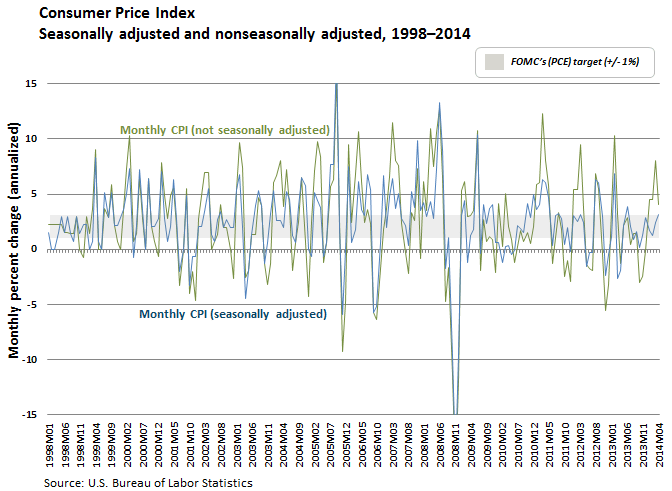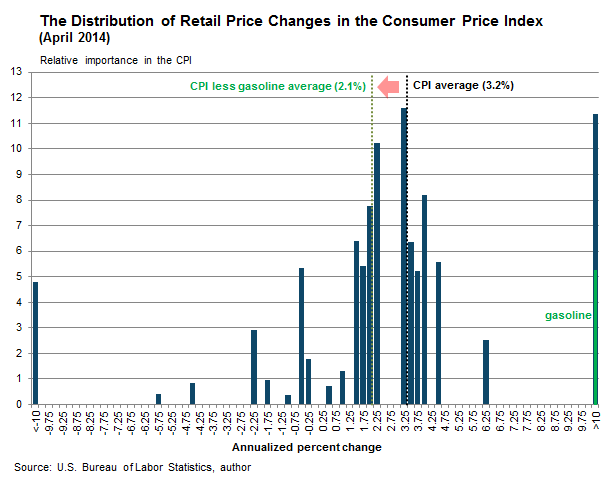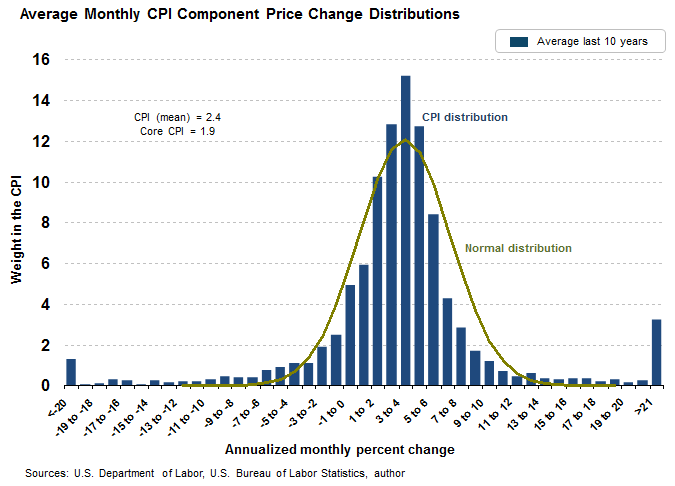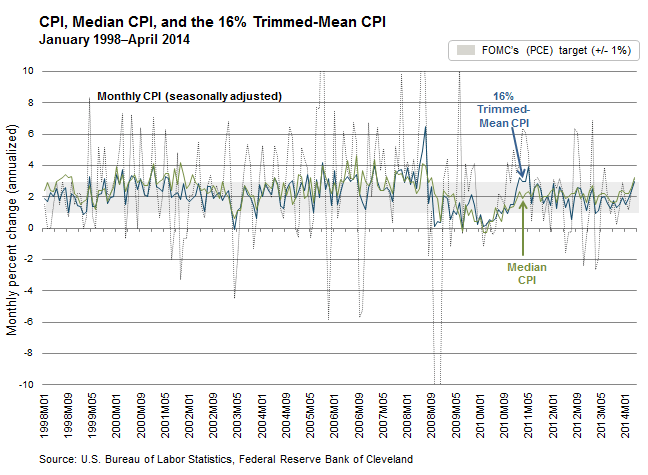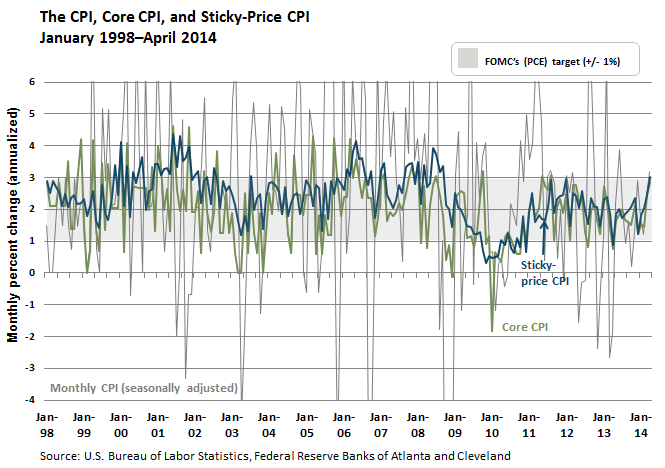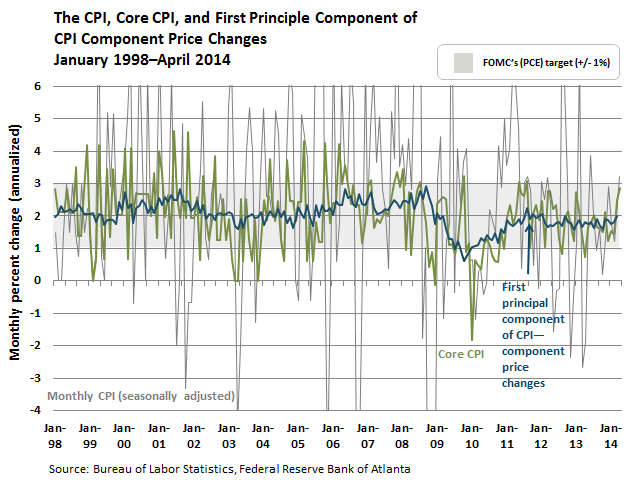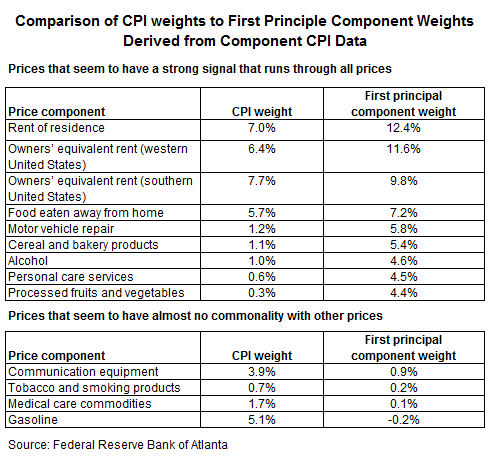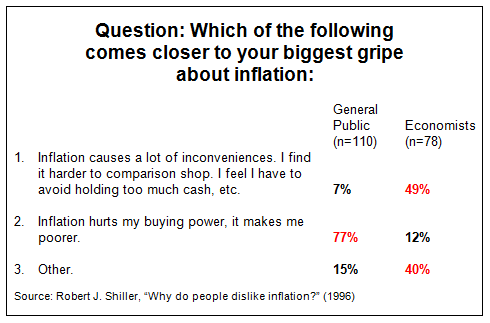Michael F. Bryan
Vice President and Senior Economist
Federal Reserve Bank of Atlanta
Remarks at the Federal Reserve Bank of Cleveland's conference on Inflation, Monetary Policy, and the Public
May 30, 2014

Please keep in mind that these are my personal views. They don't necessarily reflect the views of my colleagues at the Atlanta Fed and in the Federal Reserve System.
The median CPI and other trimmed-mean estimators
A useful place to begin this conversation, I think, is with the following chart, which shows the monthly, annualized change in the CPI. The chart shows two versions: The first is the seasonally adjusted CPI, which is what the media most commonly reports on. The second is the nonseasonally adjusted CPI, which is what the price statistic looks like before the BLS filters out the movements in the component price data that appear to be regular, or "seasonal," in occurrence.
Seasonal adjustment reduces the monthly volatility in the CPI by about 40 percent—but it is still an exceptionally volatile statistic. The monthly CPI often swings between a negative reading and a reading in excess of 5 percent. In fact, in only about one-third of the readings over the past 16 years was the monthly seasonally adjusted CPI within a percentage point of 2 percent—the FOMC's longer-term inflation target. (Officially, the FOMC's target is based on the Personal Consumption Expenditures price index, but these and related observations hold for that price index equally well.)
How should the central bank think about its price-stability mandate within the context of these large monthly CPI fluctuations? For example, does April's 3.2 percent CPI increase argue that the FOMC ought to do something to beat back the inflationary threat? I don't speak for the FOMC, but I doubt it. More likely, there were some unusual price movements within the CPI's market basket that can explain why the April CPI increase isn't likely to persist. But disentangling which price movements we should pay attention to from those we should ignore is a risky business.
The Economist retells a conversation with Stephen Roach, who in the 1970s worked for the Federal Reserve under Chairman Arthur Burns. Roach remembers that when oil prices surged around 1973, Burns asked Federal Reserve Board economists to strip those prices out of the CPI "to get a less distorted measure. When food prices then rose sharply, they stripped those out too—followed by used cars, children's toys, jewellery, housing and so on, until around half of the CPI basket was excluded because it was supposedly 'distorted'" by forces outside the control of the central bank. The story goes on to say that, at least in part because of these actions, the Fed failed to spot the breadth of the inflationary threat of the 1970s.
I have a similar story. I remember a morning in 1991 at a meeting of the Federal Reserve Bank of Cleveland's board of directors. I was welcomed to the lectern with, "Now it's time to see what Mike is going to throw out of the CPI this month." It was an uncomfortable moment for me and it had a lasting influence. It was my motivation for constructing the Cleveland Fed's median CPI.
I am a reasonably skilled reader of a monthly CPI release. And since I approached each monthly report with a pretty clear idea of what the actual rate of inflation was, it was always pretty easy for me to look across the items in the CPI market basket and identify any offending—or "distorted"—price change. Stripping these items from the price statistic revealed truth—and confirmed that I was right all along about the actual rate of inflation.
Let me show you what I mean by way of the April CPI report. The next chart shows the annualized percentage change for each component in the April CPI. These are shown on the horizontal axis. The vertical axis shows the weight given to each of these price changes in the computation of the overall CPI. Taken as a whole, the CPI jumped 3.2 percent. But out there on the far right tail of this distribution are gasoline prices. They rose about 32 percent last month. If you subtract out gasoline from the April CPI report, you get an increase of 2.1 percent. That's reasonably close to price stability—we can stop there, mission accomplished.
But here's the thing: there is no such thing as a "nondistorted" price. All prices are being influenced by market forces and, once influenced, are also influencing the prices of all the other goods in the market basket.
What else is out there on the tails of the CPI price-change distribution? Lots of stuff. About 17 percent of things people buy actually declined in price in April while prices for about 13 percent of the market basket increased at rates above 5 percent.
But it's not just the tails of this distribution that are worth thinking about. Near the center of this price-change distribution is a very high proportion of things people buy. For example, price changes within the fairly narrow range of 1.5 percent to 2.5 percent accounted for about 26 percent of the overall CPI market basket in April.
The April CPI report is hardly unusual. The CPI report is commonly one where we see a very wide range of price changes, commingled with an unusually large share of price increases that are very near the center of the price-change distribution. Statisticians call this a distribution with a high level of "excess kurtosis."
The following chart shows what an average monthly CPI price report looks like. The point of this chart is to convince you that the unusual distribution of price changes we saw in the April CPI report is standard fare. A very high proportion of price changes within the CPI market basket tends to remain close to the center of the distribution, and those price changes that do not tend to be spread over a very wide range, resulting in what appear to be very elongated tails.
And this characterization of price changes is not at all special to the CPI. It characterizes every major price aggregate I have ever examined, including the retail price data for Brazil, Argentina, Mexico, Columbia, South Africa, Israel, the United Kingdom, Sweden, Canada, New Zealand, Germany, Japan, and Australia.
Why do price-change distributions have peaked centers and very elongated tails? At one time, Steve Cecchetti and I speculated that the cost associated with unplanned price changes—called menu costs—discourage all but the most significant price adjustments. These menu costs could create a distribution of observed price changes where a large number of planned price adjustments occupy the center of the distribution, commingled with extreme, unplanned price adjustments that stretch out along its tails.
But absent a clear economic rationale for this unusual distribution, it presents a measurement problem and an immediate remedy. The problem is that these long tails will tend to cause the CPI (and other weighted averages of prices) to fluctuate pretty widely from month to month, but they are, in a statistical sense, tethered to that large proportion of price changes that lie in the center of the distribution.1
So my belated response to the Cleveland board of directors was the computation of the weighted median CPI that I produced with Chris Pike. This statistic considers only the middle-most monthly price change in the CPI market basket, which becomes the representative aggregate price change. The median CPI is immune to the analyst bias that I had been guilty of, while greatly reducing the volatility in the monthly CPI report in a way that I thought gave the Federal Reserve Bank of Cleveland a clearer read of the central tendency of price changes.
Cecchetti and I pushed the idea to a range of trimmed-mean estimators, for which the median is simply an extreme case. Trimmed-mean estimators trim some proportion of the tails from this price-change distribution and reaggregate the interior remainder. Others extended this idea to asymmetric trims for skewed price-change distributions, as Scott Roger did for New Zealand, and to other price statistics, like the Federal Reserve Bank of Dallas's trimmed-mean PCE inflation rate.
How much one should trim from the tails isn't entirely obvious. We settled on the 16 percent trimmed mean for the CPI (that is, trimming the highest and lowest 8 percent from the tails of the CPI's price-change distribution) because this is the proportion that produced the smallest monthly volatility in the statistic while preserving the same trend as the all-items CPI.
The following chart shows the monthly pattern of the median CPI and the 16 percent trimmed-mean CPI relative to the all-items CPI. Both measures reduce the monthly volatility of the aggregate price measure by a lot—and even more so than simply subtracting from the index the often-offending food and energy items.
But while the median CPI and the trimmed-mean estimators are often referred to as "core" inflation measures (and I have done this myself), these measures are very different from the CPI excluding food and energy.
In fact, I would not characterize these trimmed-mean measures as "exclusionary" statistics at all. Unlike the CPI excluding food and energy, the median CPI and the assortment of trimmed-mean estimators do not fundamentally alter the underlying weighting structure of the CPI from month to month. As long as the CPI price change distribution is symmetrical, these estimators are designed to track along the same path as that laid out by the headline CPI. It's just that these measures are constructed so that they follow that path with much less volatility (the monthly variance in the median CPI is about 95 percent smaller than the all-items CPI and about 25 percent smaller than the CPI less food and energy).
I think of the trimmed-mean estimators and the median CPI as being more akin to seasonal adjustment than they are to the concept of core inflation. (Indeed, early on, Cecchetti and I showed that the median CPI and associated trimmed-means also did a good job of purging the data of its seasonal nature.) The median CPI and trimmed-mean estimators are noise-reduced statistics where the underlying signal being identified is the CPI itself, not some alternative aggregation of price data.
This is not true of the CPI excluding food and energy, nor necessarily of other so-called measures of "core" inflation. Core inflation measures alter the weights of the price statistic so that they can no longer pretend to be approximations of the cost of living. They are different constructs altogether.
Is it more expensive, or does it just cost more money? Inflation versus cost of living
Let me make two claims that I believe are, separately, uncontroversial among economists. Jointly, however, I think they create an incongruity for how we think about, and measure, inflation.
The first claim is that, over time, inflation is a monetary phenomenon. It is caused by too much money chasing a limited number of things to buy with that money. As such, the control of inflation is rightfully the responsibility of the institution that has monopoly control over the supply of money—the central bank.
My second claim is that the cost of living is a real concept, and changes in the cost of living will occur even in a world without money. It is a description of how difficult it is to buy a particular level of well-being. Indeed, to a first approximation, changes in the cost of living are beyond the ability of a central bank to control.
For this reason, I think it is entirely appropriate to think about whether the cost of living in New York City is rising faster or slower than in Cleveland, just as it is appropriate to ask whether the cost of living of retirees is rising faster or slower than it is for working-aged people. The folks at the Bureau of Labor Statistics produce statistics that can help us answer these and many other questions related to how expensive it is to buy the happiness embodied in any particular bundle of goods.
But I think it is inappropriate for us to think about inflation, the object of central bank control, as being different in New York than it is in Cleveland, or to think that inflation is somehow different for older citizens than it is for younger citizens. Inflation is common to all things valued by money.
Yet changes in the cost of living and inflation are commonly talked about as if they are the same thing. And this creates both a communication and a measurement problem for the Federal Reserve and other central banks around the world.
Here is the essence of the problem as I see it: money is not only our medium of exchange but also our numeraire—our yardstick for measuring value. Embedded in every price change, then, are two forces. The first is real in the sense that the good is changing its price in relation to all the other prices in the market basket. It is the cost adjustment that motivates you to buy more or less of that good. The second force is purely nominal. It is a change in the numeraire caused by an imbalance in the supply and demand of the money being provided by the central bank. I think the concept of "core inflation" is all about trying to measure changes in this numeraire. But to get there, we need to first let go of any "real" notion of our price statistics. Let me explain.
Letting go of expenditure weights in favor of "inflation" weights
As a cost-of-living approximation, the weights used to construct the CPI are based on some broadly representative consumer's expenditure. It is easy to understand that since medical care costs are more important to the typical household budget than, say, haircuts, these costs should get a greater weight in the computation of an individual's cost of living. But does inflation somehow affect medical care prices differently than haircuts? I'm open to the possibility that the answer to this question is yes. It seems to me that if monetary policy has predictable, real effects on the economy then there will be a policy-induced disturbance in relative prices that temporarily alters the cost of living in some way.
But if inflation is a nominal experience that is independent of the cost of living, then the inflation component of medical care is the same as that in haircuts. No good or service, geographic region, or individual experiences inflation any differently than any other. Inflation is a common signal that ultimately runs through all wages and prices.
And when we open up to the idea that inflation is a nominal, not real concept, we begin to think about the BLS's market basket in a fundamentally different way than what the BLS intends to measure.
This, I think, is the common theme that runs through all measures of "core" inflation. Can the prices the BLS collects be reorganized or reweighted in a way that makes the aggregate price statistic more informative about the inflation that the central bank hopes to control? I think the answer is yes.
The CPI excluding food and energy is one very crude way. Food and energy prices are extremely volatile and certainly point to nonmonetary forces as their primary drivers.
In the early 1980s, Otto Eckstein defined core inflation as the trend growth rate of the cost of the factors of production—the cost of capital and wages. I would compare Eckstein's measure to the "inflation expectations" component that most economists (and presumably the Federal Open Market Committee) think "anchor" the inflation trend.
The sticky-price CPI
Brent Meyer and I have taken this idea to the CPI data. One way that prices appear to be different is in their observed "stickiness." That is, some prices tend to change quite frequently, while others do not. Prices that change only infrequently will be more forward-looking than those are change all the time. So we can take the CPI market basket and separate it into two groups of prices—prices that tend to be flexible and those that are "sticky" (a separation made possible by the work of Mark Bils and Pete Klenow).
Indeed, we find that the part of the CPI market basket that changes prices frequently (about 30 percent of the CPI) is very responsive to changes in economic conditions, but does not seem to have a very forward-looking character. But the 70 percent of the market basket that does not change prices very often—the sticky-price CPI—appears to be largely immune to fluctuations in business conditions, and these items are better predictors of future price behavior. In other words, we think that some "inflation-expectation" component exists to varying degrees within each price. By reweighting the CPI market basket in a way that amplifies the behavior of the most forward-looking prices, the sticky-price CPI gives policymakers a perspective on the inflation experience that can't be seen in the headline CPI.
Here is what monthly changes in the sticky-price CPI look like compared to the all-items CPI and the traditional "core" CPI.
Let me describe another, more radical example of how we might think about reweighting the CPI market basket to measure inflation, a way of thinking that is very different from the expenditure-basket approach the BLS uses to measure the cost of living.
If we assume that inflation is ultimately a monetary event and, moreover, that the signal of this monetary inflation can be found in all prices, then we might use statistical techniques to help us identify that signal from a large number of price data. (The famous early 20th-century economist Irving Fisher described the problem as trying to track a swarm of bees by abstracting from the individual, seemingly chaotic behavior of any particular bee.)
Cecchetti and I experimented along these lines to measure a common signal running through the CPI data. The basic idea of our approach was to take the component data that the BLS supplied, make a few simple identifying assumptions, and let the data itself determine the appropriate weighting structure to the inflation estimate.2 The signal-extraction method we chose was a dynamic-factor index approach, and while we didn't pursue that work much further, others did, using more sophisticated and less restrictive signal-extraction methods. Perhaps most notable is the 2007 work of Ricardo Reis and Mark Watson.
To give you a flavor of the approach, consider the "first principal component" of the CPI price-change data. The first principal component of a data series is a statistical combination of the data that accounts for the largest share of their joint movement (or variance). It's a simple, statistically shared component that runs through all the price data.
This next chart shows the first principal component of the CPI price data, in relation to the headline CPI and the core CPI.
Again, this is a very different animal than what the folks at the BLS are trying to measure. In fact, the weights used to produce this particular common signal in the price data bear no similarity to the expenditure weights that make up the market baskets that most people buy. And why should they? The idea here doesn't depend on how important something is to the well-being of any individual, but on whether the movement in its price seems to be similar or dissimilar to the movements of all the other prices.
In the table below, I report the weight (or relative importance) of a select group of CPI components and the weight they would get on the basis of their contribution to the first principal component.
While some criticize the CPI because it overweighs housing from a cost-of-living perspective, it may be these housing components that ought to be given the greatest consideration when thinking about the inflation that the central bank controls. Likewise, according to this approach, restaurant costs, motor vehicle repair, and even a few food components ought to be taken pretty seriously in the measurement of a common inflation signal running through the price data.
And what price movements does this approach say we ought to ignore? Well, gasoline prices for one. But movements in the prices of medical care commodities, communications equipment, and tobacco products also appear to move in ways that are largely disconnected from the common thread in prices that runs through the CPI market basket.
The challenge of communication
Let me close with a few observations on the common criticism that measures of core inflation, and specifically the CPI excluding food and energy, disconnect the Federal Reserve from households and businesses "who know price changes when they see them." After all, don't the members of the FOMC eat food and use gas in their cars? Of course they do, and if it is the cost of living the central bank intended to control, the prices of these goods should necessarily be part of the conversation, notwithstanding their observed volatility.
In fact, as I noted at the beginning of the talk, 40 percent of the monthly volatility in the cost-of-living measure of the commonly reported all-items CPI has already been purged through seasonal adjustment procedures. I think communicating in terms of a seasonally adjusted price index makes a lot of sense, even if nobody actually buys things at seasonally adjusted prices.
Referencing alternative measures of inflation presents communications challenges for the central bank, to be sure. It certainly would be easier if progress toward either of the Federal Reserve's mandates could be described in terms of a single, easily understood statistic. But I don't think this is feasible for price stability, or for full employment.
And with regard to our price stability mandate, I suspect the problem of public communication runs deeper than the particular statistics we make reference to. In 1996, Robert Shiller polled people—real people, not economists—about their perceptions of inflation. What he found was a stark difference between how economists think about the word "inflation" and how folks outside a relatively small band of academics and policymakers define inflation. Consider this question: Which of the following comes closer to your biggest gripe about inflation? Here is how people responded:
Seventy-seven percent of the households in Shiller's poll picked
I wonder if, in the minds of most people, the Federal Reserve's price-stability mandate is heard as a promise to prevent things from becoming more expensive, and especially the staples of life like, well, food and gasoline. But this is not what the central bank is promising to do.
What is the Federal Reserve promising to do? Again, let me emphasize that I don't speak for the Fed; my views are my own. But to the best of my knowledge, the first "workable" definition of price stability by the Federal Reserve was Paul Volcker's 1983 description that it was a condition where "decision-making should be able to proceed on the basis that 'real' and 'nominal' values are substantially the same over the planning horizon—and that planning horizons should be suitably long."
Thirty years later, the Fed gave price stability a more explicit definition when it laid down a numerical target. Here is how the FOMC describes that target:
The inflation rate over the longer run is primarily determined by monetary policy, and hence the Committee has the ability to specify a longer-run goal for inflation. The Committee reaffirms its judgment that inflation at the rate of 2 percent, as measured by the annual change in the price index for personal consumption expenditures, is most consistent over the longer run with the Federal Reserve's statutory mandate.
Whether one goes back to the qualitative description of Paul Volcker, or the quantitative description in the FOMC's recent statement of principles, the thrust is broadly the same. The central bank is intent on managing that longer-term, nominal trend in the price level that is determined by monetary policy, not the real fluctuations that are reflective of changes
in the cost-of-living faced by households. And achieving price stability in the sense described above requires that the central bank and the public are talking about the same thing when communicating about inflation.
Prices are volatile, and the cost of living the public experiences ought to reflect that. But what the central bank can control over time—inflation—is obscured within these fluctuations. What my work and the work of my coauthors have attempted to do is to rearrange the price data at our disposal, and so reveal a richer perspective on the inflation experience.
Thank you.
1 Said in the language of statistics, the weighted mean of this price change distribution is pretty inefficient and makes the central tendency in the data harder to see.
2 In 2002, we, along with Roisin O'Sullivan, expanded the set of component price data to include asset and wage data, arguing that the inflation signal runs through all nominal prices. See Bryan, Cecchetti, and O'Sullivan, "Asset Prices in the Measurement of Inflation," NBER Working Paper no. 8700, January 2002.



